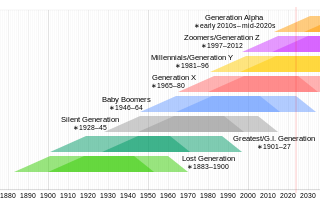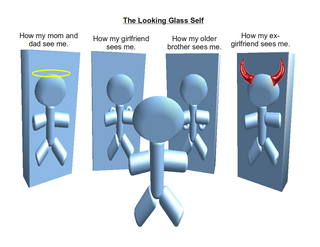Related Research Articles
Flaming, also known as roasting, is the act of posting insults, often including profanity or other offensive language, on the internet. This term should not be confused with the term trolling, which is the act of someone causing discord online or in person. Flaming emerged from the anonymity that Internet forums provide cover for users to act more aggressively. Anonymity can lead to disinhibition, which results in the swearing, offensive, and hostile language characteristic of flaming. Lack of social cues, less accountability of face-to-face communications, textual mediation and deindividualization are also likely factors. Deliberate flaming is carried out by individuals known as flamers, which are specifically motivated to incite flaming. These users specialize in flaming and target specific aspects of a controversial conversation.

Embarrassment or awkwardness is an emotional state that is associated with mild to severe levels of discomfort, and which is usually experienced when someone commits a socially unacceptable or frowned-upon act that is witnessed by or revealed to others. Frequently grouped with shame and guilt, embarrassment is considered a "self-conscious emotion", and it can have a profoundly negative impact on a person's thoughts or behavior.

Body image is a person's thoughts, feelings and perception of the aesthetics or sexual attractiveness of their own body. The concept of body image is used in several disciplines, including neuroscience, psychology, medicine, psychiatry, psychoanalysis, philosophy, cultural and feminist studies; the media also often uses the term. Across these disciplines, there is no single consensus definition, but broadly speaking, body image consists of the ways people view themselves; their memories, experiences, assumptions, and comparisons about their appearances; and their overall attitudes towards their respective heights, shapes, and weights—all of which are shaped by prevalent social and cultural ideals.
Impression management is a conscious or subconscious process in which people attempt to influence the perceptions of other people about a person, object or event by regulating and controlling information in social interaction. It was first conceptualized by Erving Goffman in 1959 in The Presentation of Self in Everyday Life, and then was expanded upon in 1967.
Self-hatred is personal self-loathing or hatred of oneself, or low self-esteem which may lead to self-harm.
Rational emotive behavior therapy (REBT), previously called rational therapy and rational emotive therapy, is an active-directive, philosophically and empirically based psychotherapy, the aim of which is to resolve emotional and behavioral problems and disturbances and to help people to lead happier and more fulfilling lives.
Social comparison theory, initially proposed by social psychologist Leon Festinger in 1954, centers on the belief that individuals drive to gain accurate self-evaluations. The theory explains how individuals evaluate their opinions and abilities by comparing themselves to others to reduce uncertainty in these domains and learn how to define the self. Comparing oneself to others socially is a form of measurement and self-assessment to identify where an individual stands according to their own set of standards and emotions about themselves.
The third-person effect hypothesis predicts that people tend to perceive that mass media messages have a greater effect on others than on themselves, based on personal biases. The third-person effect manifests itself through an individual's overestimation of the effect of a mass communicated message on the generalized other, or an underestimation of the effect of a mass communicated message on themselves.
Personal branding is the conscious and intentional effort to create and influence public perception of an individual by positioning them as an authority in their industry, elevating their credibility, and differentiating themselves from the competition, to ultimately advance their career, widen their circle of influence, and have a larger impact.

Generation Z, colloquially known as zoomers, is the demographic cohort succeeding millennials and preceding Generation Alpha. Researchers and popular media use the mid-to-late 1990s as starting birth years and the early 2010s as ending birth years. Most members of Generation Z are the children of Generation X or younger baby boomers.

The term looking-glass self was created by American sociologist Charles Horton Cooley in 1902, and introduced into his work Human Nature and the Social Order. It is described as our reflection of how we think we appear to others. Cooley takes into account three steps when using "the looking glass self". Step one is how one imagines one looks to other people. Step two is how one imagines the judgment of others based on how one thinks they view them. Step three is how one thinks of how the person views them based on their previous judgments.

Social media are interactive technologies that facilitate the creation and sharing of content, ideas, interests, and other forms of expression through virtual communities and networks. Social media refers to new forms of media that involve interactive participation. While challenges to the definition of social media arise due to the variety of stand-alone and built-in social media services currently available, there are some common features:
- Social media are interactive Web 2.0 Internet-based applications.
- User-generated content—such as text posts or comments, digital photos or videos, and data generated through all online interactions—is the lifeblood of social media.
- Users create service-specific profiles for the website or app that are designed and maintained by the social media organization.
- Social media helps the development of online social networks by connecting a user's profile with those of other individuals or groups.
Communication accommodation theory (CAT) is a theory of communication developed by Howard Giles. This theory concerns "(1) the behavioral changes that people make to attune their communication to their partner, (2) the extent to which people perceive their partner as appropriately attuning to them." The basis of the theory lies in the idea that people adjust their style of speech to one another. Doing this helps the message sender gain approval from the receiver, increases efficiency in communication between both parties, and helps the sender maintain a positive social identity. This theory is concerned with the links between language, context, and identity. It focuses on both the intergroup and interpersonal factors that lead to accommodation, as well as the ways that power, macro- and micro-context concerns affect communication behaviors; emphasizing the important duplexity of both factors in predicting and understanding intergroup interactions. Accommodation is usually considered to be between the message sender and the message receiver, but the communicator also often accommodates to a larger audience – either a group of people that are watching the interaction or society in general. Communication Accommodation Theory (CAT) predicts and explains why communicants make adjustments to increase, decrease, or maintain social distance.
In social psychology, the pratfall effect is the tendency for interpersonal appeal to change after an individual makes a mistake, depending on the individual's perceived competence. In particular, highly competent individuals tend to become more likeable after committing mistakes, while average-seeming individuals tend to become less likeable even if they commit the same mistake.
Self-enhancement is a type of motivation that works to make people feel good about themselves and to maintain self-esteem. This motive becomes especially prominent in situations of threat, failure or blows to one's self-esteem. Self-enhancement involves a preference for positive over negative self-views. It is one of the three self-evaluation motives along with self-assessment and self-verification . Self-evaluation motives drive the process of self-regulation, that is, how people control and direct their own actions.
Ingratiating is a psychological technique in which an individual attempts to influence another person by becoming more likeable to their target. This term was coined by social psychologist Edward E. Jones, who further defined ingratiating as "a class of strategic behaviors illicitly designed to influence a particular other person concerning the attractiveness of one's personal qualities." Ingratiation research has identified some specific tactics of employing ingratiation:

Self-image is the mental picture, generally of a kind that is quite resistant to change, that depicts not only details that are potentially available to an objective investigation by others, but also items that have been learned by persons about themselves, either from personal experiences or by internalizing the judgments of others.
Social tuning, the process whereby people adopt other people's attitudes, is cited by social psychologists to demonstrate an important lack of people's conscious control over their actions.
Diaosi is a Chinese slang and internet buzzword, often used in a sarcastic and self-deprecating manner, that refers to a young male of mediocre appearance and social standing. Born into a humble family, he has no car, no house, and no connections. Yet as the term went viral on the Internet, Chinese youth from all backgrounds began to embrace it. It is slowly transforming into a descriptor of the ordinary Chinese citizen who faces everyday struggles and hardships.
Respectability politics, or the politics of respectability, is a political strategy wherein members of a marginalized community will consciously abandon or punish controversial aspects of their cultural-political identity as a method of assimilating, achieving social mobility, and gaining the respect of the majority culture. As a sociological term, it is often pejorative, typically used in a manner critical of the ideology.
References
- ↑ "Self-deprecation". The Free Dictionary. Farlex. Retrieved 2010-06-08.
- ↑ Self-Deprecation - Personality & Spirituality
- ↑ Self-deprecation | Define Self-deprecation at Dictionary.com
- 1 2 Speer, Susan A. (2019). "Reconsidering self‐deprecation as a communication practice". The British Journal of Social Psychology. 58 (4): 806–828. doi:10.1111/bjso.12329. ISSN 0144-6665. PMC 6851542 . PMID 31102414.
- ↑ Jesper (2021-07-20). "Stop Seeking Approval: Respond to Insults Like a Stoic". Mind & Practice. Retrieved 2023-08-28.
- ↑ Irvine, William B. (2017) [2013]. A Slap in the Face: Why Insults Hurt—And Why They Shouldn't. Oxford University Press. ISBN 978-0-19-066504-3. OCLC 1004818985.
- 1 2 McMullin, C. (2019). "Self-Depreciation: Why Do We Do It?". From Backpacks to Briefcases. Arcadia University. Retrieved 2022-02-24.
- 1 2 3 4 5 Austin, Adrienne B.; Costabile, Kristi A.; Smith, Lauren (2021). "Social judgements, social media, and self-deprecation: Role of information source and valence on trait and favorability judgements". Journal of Media Psychology. doi:10.1027/1864-1105/a000299. S2CID 238075562.
- 1 2 Mills, Sara (2017). "§ 3.3.4 Self-deprecation". English Politeness and Class. Cambridge University Press. pp. 66–68. ISBN 978-1-108-34041-0.
- ↑ "Self-Deprecation". Debrett's. Archived from the original on 5 April 2014. Retrieved 4 May 2014.
- ↑ Muresianu, John (2 August 2021). "Liberal Arts Blog — Rodney Dangerfield (1921–2004) and the Art of Self-Deprecation". Medium. Retrieved November 29, 2021.
- ↑ Forward, The (2009-06-10). "Is self-deprecation killing Jewish comedy? - Israel News | Haaretz Daily Newspaper". Haaretz.com. Retrieved 2013-07-01.
- ↑ Sarah, Osman. "CHATTING WITH: "NATHAN FOR YOU" CREATOR NATHAN FIELDER". Young Hollywood. Retrieved November 20, 2016.
- ↑ "Don Knotts Obituary: View Don Knotts's Obituary by The Washington Post". Legacy.com. 2006-02-25. Retrieved 2013-07-01.
- ↑ Morris, Wesley (2010-06-20). "The many faces of Joan Rivers". The Boston Globe.
- 1 2 "Antisocial network: how self-deprecation is taking over the internet". The Guardian. 2016-05-25. Retrieved 2022-02-24.
- 1 2 Zizzo, Kira. "How Self-Deprecating Humor has Defined the Mental Health Issues of Gen Z in an Alarming Way". the Rock Online. Retrieved 2022-02-24.
- 1 2 "Self-deprecation on social media: for expression or for likes?". The Journal. Queen's University. 2017. Retrieved 2022-02-26.